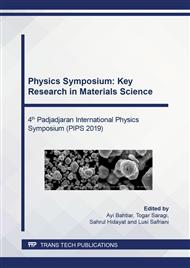[1]
D.C. Schmitz, J.D. Schardt, A.G. Leslie, F.A. Dray, J.A. Osborne, B.V. Nelson, The ecological impact and management history of three invasive alien aquatic plants in Florida, in: B.N. McKnight (Ed.), Biological Pollution the Control and Impact of Invasive Exotic Species, Indiana Academy of Science, Indianapolis, 1993, p.261.
Google Scholar
[2]
S. Roman, B. Ledesma, A. Alvarez, C. Coronella, S.V. Qaramaleki. Suitability of hydrothermal carbonization to convert water hyacinth to added-value products. Renew. Energy 146 (2020) 1649-1658.
DOI: 10.1016/j.renene.2019.07.157
Google Scholar
[3]
R. Sindhu, P. Binod, A. Pandey, A. Madhavan, J.A. Alphonsa, N. Vivek, E. Gnansounou, E. Castro, V. Faraco, Water hyacinth a potential source for value addition: An overview. Bioresour. Technol. 230 (2017) 152–162.
DOI: 10.1016/j.biortech.2017.01.035
Google Scholar
[4]
K. Rop, D. Mbui, N. Njomo, G.N. Karuku, I. Michira, R.F. Ajayi, Biodegradable water hyacinth cellulose-graft-poly(ammonium acrylate-co-acrylic acid) polymer hydrogel for potential agricultural application, Heliyon 5 (2019) e01416 (29 pages).
DOI: 10.1016/j.heliyon.2019.e01416
Google Scholar
[5]
S. Hidayat, Susanty, N. Riveli, B.J. Suroto, I. Rahayu. Synthesis and characterization of CMC from water hyacinth for lithium-ion battery applications, AIP Conf. Proc. 1927 (2018), 030023 (5 pages).
DOI: 10.1063/1.5021216
Google Scholar
[6]
H.M. Ali, D. Zageer, A.H. Alwash, Synthesis of activated carbon from Eichhronia crassipes plant as adsorbent for the removal of phenol from aqueous solution, Al-Nahrain J. Sci. 22 (2019) 46-54.
DOI: 10.22401/anjs.22.1.07
Google Scholar
[7]
A. Wazeri, M. Elsamadony, A. Tawfik, Carbon emissions reduction by catalyzing H2 gas harvested fromwater hyacinth fermentation process using metallic salts, Energy Procedia 152 (2018) 1254–1259.
DOI: 10.1016/j.egypro.2018.09.178
Google Scholar
[8]
V.B. Barua, A.S. Kalamdhad, Biogas production from water hyacinth in a novel anaerobic digester: A continuous study, Process Saf. Environ. Protect. 127 (2019) 82–89.
DOI: 10.1016/j.psep.2019.05.007
Google Scholar
[9]
K. Zheng, Y. Li, M. Zhu, X. Yu, M. Zhang, L. Shi, J. Cheng, The porous carbon derived from water hyacinth with well-designed hierarchical structure for supercapacitors, J. Power Sources 366 (2017) 270-277.
DOI: 10.1016/j.jpowsour.2017.09.034
Google Scholar
[10]
F. Kurniawan, M. Wongso, A. Ayucitra, F.E. Soetaredjo, A.E. Angkawijaya, Y.-H. Ju, S. Ismadji, Carbon microsphere from water hyacinth for supercapacitor electrode, J. Taiwan Inst. Chem. Eng. 47 (2015) 197–201.
DOI: 10.1016/j.jtice.2014.10.002
Google Scholar
[11]
S.A. Soenjaya, N. Handoyo, F.E. Soetaredjo, A.E. Angkawijaya, Y.-H. Ju, S. Ismadji, Preparation of carbon fiber from water hyacinth liquid tar, Int. J. Ind. Chem. 6 (2015) 1–7.
DOI: 10.1007/s40090-014-0026-4
Google Scholar
[12]
K Wu, B. Gao, J. Su, X. Peng, X. Zhang, J. Fu, S. Peng, P.K. Chu, Large and porous carbon sheets derived from water hyacinth for high performance supercapacitors, RSC Adv. 6 (2016) 29996–30003.
DOI: 10.1039/c5ra25098f
Google Scholar
[13]
S. Bhati, J.S. Mahur, S. Dixit, O.N. Chobey, Study on effect of chemical impregnation on the surface and porous characteristics of activated carbon fabric prepared from viscose rayon, Carbon Lett. 15 (2014) 45-49.
DOI: 10.5714/cl.2014.15.1.045
Google Scholar
[14]
Z. Gao, Y. Zhang, N. Song, X. Li, Biomass-derived renewable carbon materials for electrochemical energy storage, Mater. Res. Lett. 5 (2017) 69–88.
Google Scholar


